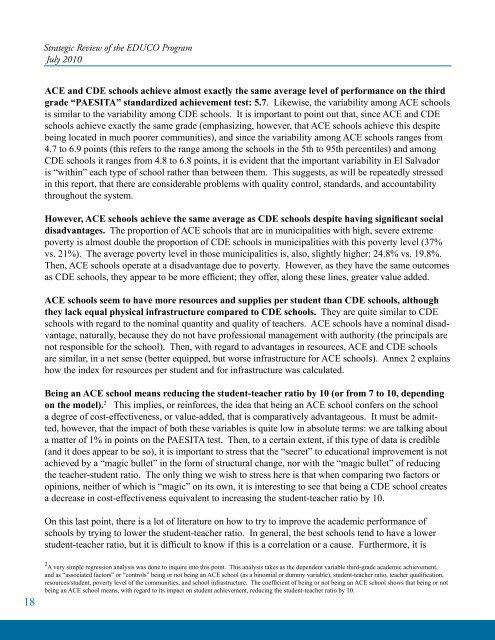Strategic Review of the EDUCO Program - EQUIP123.net
Strategic Review of the EDUCO Program - EQUIP123.net
Strategic Review of the EDUCO Program - EQUIP123.net
Create successful ePaper yourself
Turn your PDF publications into a flip-book with our unique Google optimized e-Paper software.
<strong>Strategic</strong> <strong>Review</strong> <strong>of</strong> <strong>the</strong> <strong>EDUCO</strong> <strong>Program</strong>July 2010ACE and CDE schools achieve almost exactly <strong>the</strong> same average level <strong>of</strong> performance on <strong>the</strong> thirdgrade “PAESITA” standardized achievement test: 5.7. Likewise, <strong>the</strong> variability among ACE schoolsis similar to <strong>the</strong> variability among CDE schools. It is important to point out that, since ACE and CDEschools achieve exactly <strong>the</strong> same grade (emphasizing, however, that ACE schools achieve this despitebeing located in much poorer communities), and since <strong>the</strong> variability among ACE schools ranges from4.7 to 6.9 points (this refers to <strong>the</strong> range among <strong>the</strong> schools in <strong>the</strong> 5th to 95th percentiles) and amongCDE schools it ranges from 4.8 to 6.8 points, it is evident that <strong>the</strong> important variability in El Salvadoris “within” each type <strong>of</strong> school ra<strong>the</strong>r than between <strong>the</strong>m. This suggests, as will be repeatedly stressedin this report, that <strong>the</strong>re are considerable problems with quality control, standards, and accountabilitythroughout <strong>the</strong> system.However, ACE schools achieve <strong>the</strong> same average as CDE schools despite having significant socialdisadvantages. The proportion <strong>of</strong> ACE schools that are in municipalities with high, severe extremepoverty is almost double <strong>the</strong> proportion <strong>of</strong> CDE schools in municipalities with this poverty level (37%vs. 21%). The average poverty level in those municipalities is, also, slightly higher: 24.8% vs. 19.8%.Then, ACE schools operate at a disadvantage due to poverty. However, as <strong>the</strong>y have <strong>the</strong> same outcomesas CDE schools, <strong>the</strong>y appear to be more efficient; <strong>the</strong>y <strong>of</strong>fer, along <strong>the</strong>se lines, greater value added.ACE schools seem to have more resources and supplies per student than CDE schools, although<strong>the</strong>y lack equal physical infrastructure compared to CDE schools. They are quite similar to CDEschools with regard to <strong>the</strong> nominal quantity and quality <strong>of</strong> teachers. ACE schools have a nominal disadvantage,naturally, because <strong>the</strong>y do not have pr<strong>of</strong>essional management with authority (<strong>the</strong> principals arenot responsible for <strong>the</strong> school). Then, with regard to advantages in resources, ACE and CDE schoolsare similar, in a net sense (better equipped, but worse infrastructure for ACE schools). Annex 2 explainshow <strong>the</strong> index for resources per student and for infrastructure was calculated.Being an ACE school means reducing <strong>the</strong> student-teacher ratio by 10 (or from 7 to 10, dependingon <strong>the</strong> model). 2 This implies, or reinforces, <strong>the</strong> idea that being an ACE school confers on <strong>the</strong> schoola degree <strong>of</strong> cost-effectiveness, or value-added, that is comparatively advantageous. It must be admitted,however, that <strong>the</strong> impact <strong>of</strong> both <strong>the</strong>se variables is quite low in absolute terms: we are talking abouta matter <strong>of</strong> 1% in points on <strong>the</strong> PAESITA test. Then, to a certain extent, if this type <strong>of</strong> data is credible(and it does appear to be so), it is important to stress that <strong>the</strong> “secret” to educational improvement is notachieved by a “magic bullet” in <strong>the</strong> form <strong>of</strong> structural change, nor with <strong>the</strong> “magic bullet” <strong>of</strong> reducing<strong>the</strong> teacher-student ratio. The only thing we wish to stress here is that when comparing two factors oropinions, nei<strong>the</strong>r <strong>of</strong> which is “magic” on its own, it is interesting to see that being a CDE school createsa decrease in cost-effectiveness equivalent to increasing <strong>the</strong> student-teacher ratio by 10.On this last point, <strong>the</strong>re is a lot <strong>of</strong> literature on how to try to improve <strong>the</strong> academic performance <strong>of</strong>schools by trying to lower <strong>the</strong> student-teacher ratio. In general, <strong>the</strong> best schools tend to have a lowerstudent-teacher ratio, but it is difficult to know if this is a correlation or a cause. Fur<strong>the</strong>rmore, it is182 A very simple regression analysis was done to inquire into this point. This analysis takes as <strong>the</strong> dependent variable third-grade academic achievement,and as “associated factors” or “controls” being or not being an ACE school (as a binomial or dummy variable), student-teacher ratio, teacher qualification,resources/student, poverty level <strong>of</strong> <strong>the</strong> communities, and school infrastructure. The coefficient <strong>of</strong> being or not being an ACE school shows that being or notbeing an ACE school means, with regard to its impact on student achievement, reducing <strong>the</strong> student-teacher ratio by 10.

















